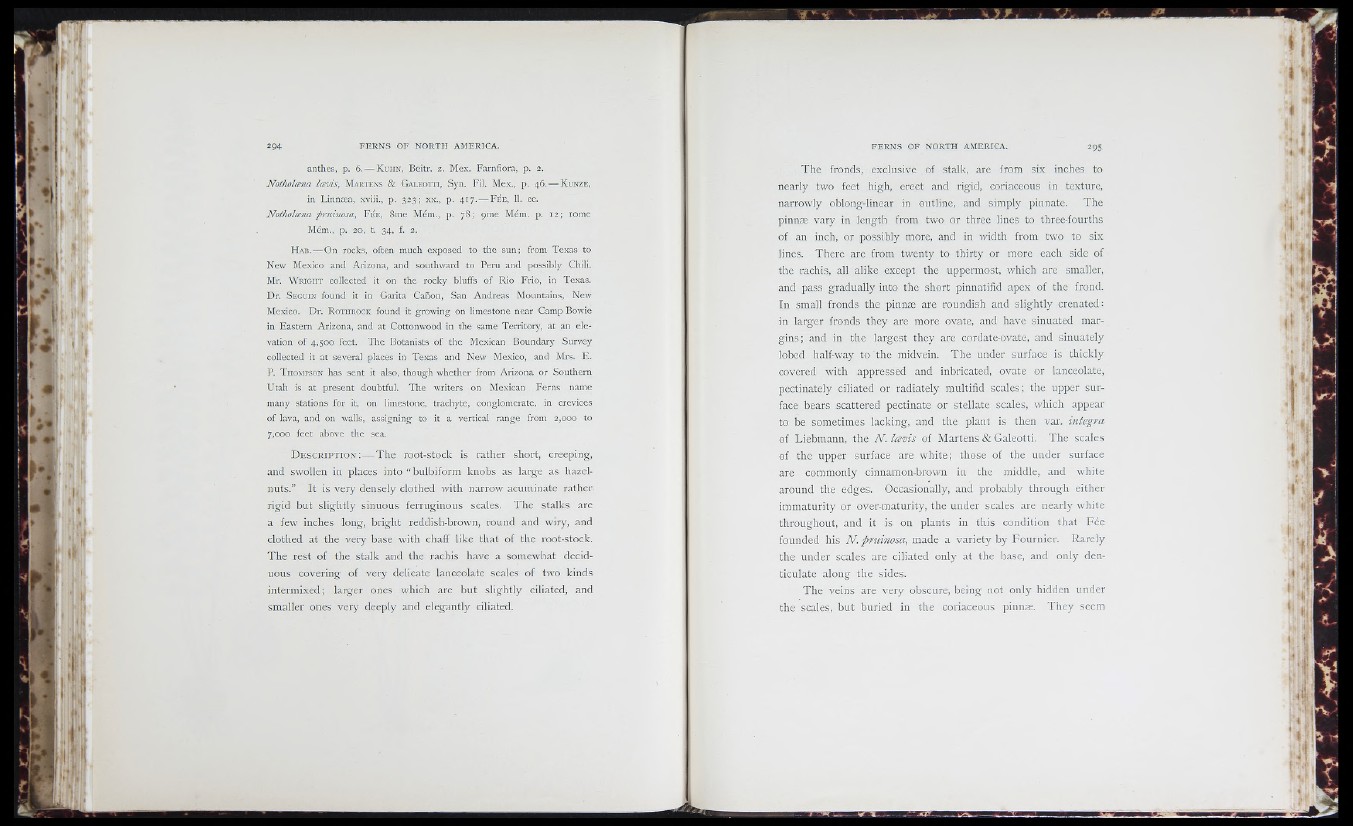
■.I
í
É *
3 ft;
i
lé , 4
lu
I
r .
H ) •
E ■ '
r i ' ' ,
>
à-\
t - J
M i
t
F .
i l »
‘ " | l |
^ k
I Ali
2 9 4 F E R N S O F N O R T H AM E R IC A .
anthes, p. 6. — K u h n , Beitr. z. Mex. Farnfiora, p. 2.
Notholcsiia loevis, M a r t e n s & G z\ l e o i t i , Syn. Fil. Mex., p. 46. — K u n z e ,
in Linnæa, xviii., p. 3 2 3 ; xx., p . 4 17 .— F É E , 11. cc.
Notholæna pruinosa, Fee, 8me Mém., p. 78; gme Mém. p. 12 ; lome
Mém., p. 20, t. 34, f. 2.
H a b . — On rocks, often much exposed to the sun; from Texas to
New Mexico and Arizona, and southward to Peru and possibly Chili.
Mr. W r i g h t collected it on the rocky bluffs of Rio Frio, in Texas.
Dr. S e g u in found it in Garita Cañón, San Andreas Mountains, New
Mexico. Dr. R o t h r o c k found it growing on limestone near Camp Bowie
in Eastern Arizona, and at Cottonwood in the same Territory, at an elevation
of 4,500 feet. The Botanists of the Mexican Boundary Survey
collected it at several places in Texas and New Mexico, and Mrs. E.
P. T h o m p s o n has sent it also, though whether from Arizona or Southern
Utah is at present doubtful. The writers on Mexican Ferns name
many stations for it, on limestone, trachyte, conglomerate, in crevices
of lava, and on walls, assigning to it a vertical range from 2,000 to
7,000 feet above the sea.
D e s c r i p t i o n : — The root-stock is rather short, creeping,
and swollen in places into “ bulbiform knobs as large as hazelnuts.”
It is very densely clothed with narrow acuminate rather
rigid but slightly sinuous ferruginous scales. The stalks are
a few inches long, bright reddish-brown, round and wiry, and
clothed at the very base with chaff like that of the root-stock.
The rest of the stalk and the rachis have a somewhat deciduous
covering of very delicate lanceolate scales of two kinds
intermixed; larger ones which are but slightly ciliated, and
smaller ones very deeply and elegantly ciliated.
*
F E R N S O F N O R TH AMER ICA. 295
The fronds, exclusive of stalk, are from six inches to
nearly two feet high, erect and rigid, coriaceous in texture,
narrowly oblong-linear in outline, and simply pinnate. The
pinnæ vary in length from two or three lines to three-fourths
of an inch, or possibly more, and in width from two to six
lines. There are from twenty to thirty or more each side of
the rachis, all alike except the uppermost, which arc smaller,
and pass gradually into the short pinnatifid apex of the frond.
In small fronds the pinnæ are roundish and slightly crenated:
in larger fronds they arc more ovate, and have sinuated margins;
and in the largest they are cordate-ovate, and sinuately
lobed half-way to the midvein. The under surface is thickly
covered with appressed and inbricated, ovate or lanceolate,
pectinately ciliated or radiately multifid scales; the upper surface
bears scattered pectinate or stellate scales, which appear
to be sometimes lacking, and the plant is then vai'. integra
of Liebmann, the N. loevis of Martens & Galeotti. The scales
of the upper surface are white; those of the under surface
are commonly cinnamon-brown in the middle, and white
around the edges. Occasionally, and probably through cither
immaturity or over-maturity, the under scales are nearly white
throughout, and it is on plants in this condition that Fée
founded his N. pminosa, made a variety by Fournier. Rarely
the under scales are ciliated only at the base, and only denticulate
along the sides.
The veins are very obscure, being not only hidden under
the scales, but buried in the coriaceous pinnæ. They seem